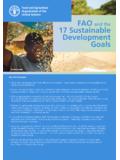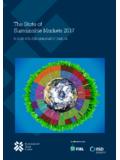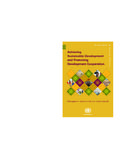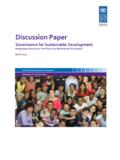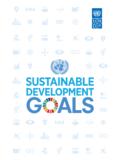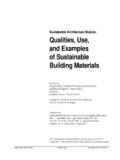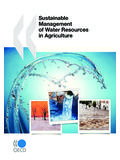Transcription of Fact sheet - Food and Agriculture Organization
1 4. CPW. Fact sheet sustainable wildlife management . AND HUMAN wildlife CONFLICT. FAO/E. Kaeslin Collaborative Partnership on sustainable wildlife management The Collaborative Partnership on sustainable wildlife management (CPW) is a voluntary partnership of inter- . national organizations with substantive mandates and programmes for the sustainable use and conservation of wildlife resources. The mission of the CPW is to increase cooperation and coordination among its members and other interested parties on sustainable wildlife management to promote the sustainable use and conservation of terrestrial vertebrate wildlife in all biomes and geographic areas.
2 sustainable wildlife management sustainable wildlife management (SWM) is the sound management of wildlife species to sustain their populations and habitat over time, taking into account the socioeconomic needs of human populations. This requires that all land-users within the wildlife habitat are aware of and consider the effects of their activities on the wildlife resources and habitat, and on other user groups. In this factsheet, the term wildlife refers to terrestrial or semi-terrestrial vertebrates . In view of its ecological, social and economic value, wildlife is an important renewable natural resource, with significance for areas such as rural development, land-use planning, food supply, tourism, scientific research and cultural heritage.
3 If sustainably managed, wildlife can provide continuous nutrition and income and contrib- ute considerably to the alleviation of poverty as well as to safeguarding human and environmental health. The objective of the fact sheets produced by the CPW is to inform decision-makers, stakeholders and the general public about issues and opportunities relating to the sustainable use and conservation of terrestrial and semi-terrestrial vertebrate wildlife . What is at stake? as well as a recurrent inability of institutions to Human wildlife conflict (HWC) occurs when the manage such conflicts effectively. Climate change needs of wildlife encroach on those of human popu- is exacerbating these conflicts through, for exam- lations or the needs of human populations encroach ple, increased competition for water and habitats.
4 Upon those of wildlife . More broadly, interactions Changing human values and attitudes are also between wildlife and humans can cause damage or shaping wildlife management approaches, where costs to both, and lead to conflicts between differ- ecocentric, protectionist views of wildlife may not ent groups of people (human human conflicts) over recognize or accommodate the needs of those wildlife and how it should be managed. living with wildlife . Conflicts between humans and wildlife , and between HWC cannot be detached from the context of humans over wildlife , have occurred since the dawn conflicts between groups of people about how to of humanity.
5 However, in many regions these con- manage wildlife , which have marked the history of flicts have intensified over recent decades as a result conservation. For example, centuries of urbanization of human population growth and the related expan- have led to radical agrarian dissent and resistance to sion of agricultural and industrial activities. Conflicts dominant urban cultures and values in many places. have also arisen due to the growth of some wildlife The implementation of protectionist conservation populations and the presence of certain species policies has often aggravated feelings of disenfran- ( red fox, wild boar) in urban environments,1 chisement and injustice among rural communities, as FAO 2015.
6 Well as frustration toward wildlife authorities. Problems A high density of large ungulates (hoofed mammals) in are particularly severe when the wildlife species con- forests can endanger the sustainability of forest man- cerned are of major conservation importance and agement by eating tree bark as well as small trees, the conservation objectives are at odds with those of which can affect forest succession and lead to a local communities. polarization between forest and wildlife management . Impacts of HWC can range from injury and death, The loss of livestock can also damage livelihoods. For loss of crops and livestock, damaged infrastructure, rural populations, domestic animals may be an impor- disease transmission (to humans and also to wildlife ) tant resource or the only source of income.
7 Predation and school absenteeism of children to guard crops at on livestock often forces rural communities to adopt home or too scared to walk to school, to reduced farm new mechanisms to protect stock, such as building productivity for farmers who are spending more time enclosures or introducing guard dogs. guarding their crops, and other intangible social costs such as stress. As a result of these negative impacts, Large herbivores often compete for food or water, particu- wildlife species may be killed in retaliation, with a risk larly in arid regions. This is the case for guanacos in of population 3 4 In certain cases, indis- South America, deer in North America, and wildebeest criminate killing of non-problematic wildlife or habitat in Africa.
8 Actions taken to decrease native herbivore destruction may also take place as an expression of populations can significantly change population sizes resentment or hostility toward conservation and wildlife and predators, and affect the people who also rely on management authorities. the resources, such as local pastoralists. Local solutions should therefore take into account Transmission of diseases to livestock and/or humans the histories of past interventions and their outcomes, Many wild species can play a major role in disease trans- including monitoring to enable appropriate modifica- mission to/from domestic animals due to their abun- tions because perceptions, as well as the populations dance, wide distribution, and close proximity to these and activities of both humans and wildlife , change over animals with which they frequently share pasture and time.
9 Watering points. Common livestock diseases such as Key issues brucellosis and bovine tuberculosis can adversely affect wildlife populations and in some cases lead to Safety and security infections that are much more difficult to control than in Large carnivores and large herbivores are responsible livestock. Diseases in wildlife can cause severe prob- for most attacks on humans, often leading to injury or lems for domestic animals but diseases in domestic death. Deaths may occur when people are in or near animals can also devastate wildlife populations and waterways, for example when travelling, fishing or fetch- threaten biological diversity.
10 Ing water; while protecting crops and water against wild animals (usually at night); or when people encoun- Of the growing list of human pathogens, 61 percent are ter injured animals whose normal sense of caution is zoonotic. Of emerging infectious diseases, 75 percent impaired. The fear of conflict restricts people's freedom are zoonotic, originating principally from wildlife . Over of movement and access to resources and can induce the past four decades, agents responsible for pan- high levels of stress and feelings of insecurity. demics such as Human Immunodeficiency Virus (HIV). Road accidents caused by wildlife and bird aircraft and other diseases that cause high case-fatality rates collisions occur worldwide, and can also result in ( Ebola virus (EBOV), Severe Acute Respiratory human death and injury.)










